Introduction to Pollination
The project attempts to study and research the possibilities of creating a green, three-dimensional corridor for pollinators in a specific area, the historical city center of Madrid, connecting Madrid’s most prominent green park “el Retiro” in the east to the “Casa de Campo” natural reserve in the west. In particular the proposal focuses on reintroducing and enhancing specific local biodiversity to cohabitate in a multi-use way and to create awareness for our dependency on pollination in an interactive mixed reality approach.
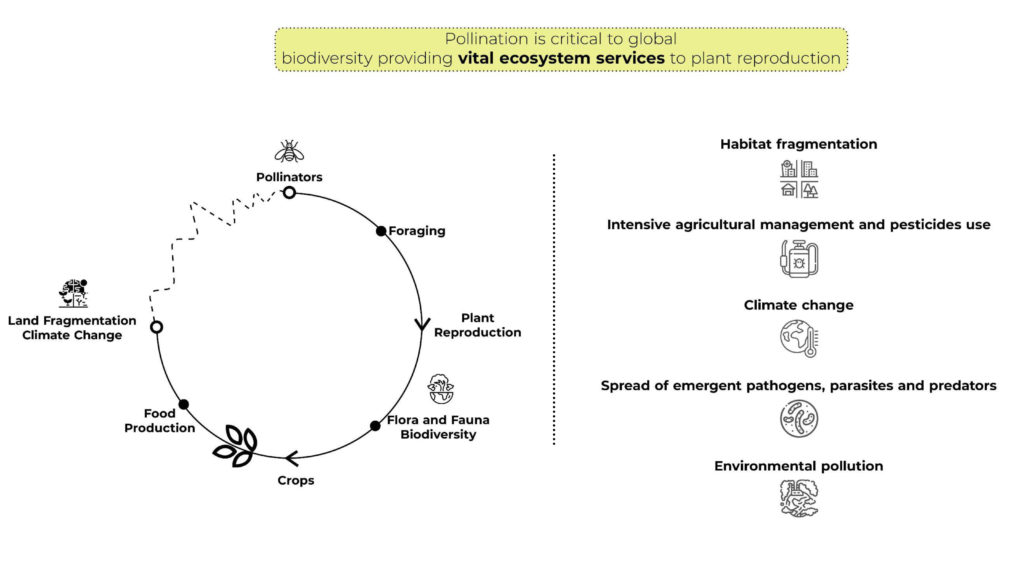
Pollination is a process that could happen with assistance of several agents like insects, water, wind, and other species including humans. This is an interdependent process between plant species and the other agents that help with the process. Among them all, certain insect species are rated to be the most proficient agents that help with carrying out the process and hence, the project is focused on creating urban habitual zones for these insect species and corridors for better navigation and flow of these species into the city.

Flora and Fauna Biodiversity
The native plant species of Madrid and the insect species was analysed to understand the interrelationship between these species to enhance the ecological factor of the city. The four most efficient insect species and their families among the several agents that contribute in pollination was considered, which are; the bees, butterflies, beetles and flies. A profile for each of these species was created to study the flight ranges of each of them, the plant species they are attracted to, the number of visitations per plant and the time period for each visitation. Similarly, the plant species that are native to Madrid and which contribute the most to enhance biodiversity within the city were listed and a study on the the seasonality of these species was done. These factors are considered to further narrow down the important players to create navigational and habitual spaces for the species involved.
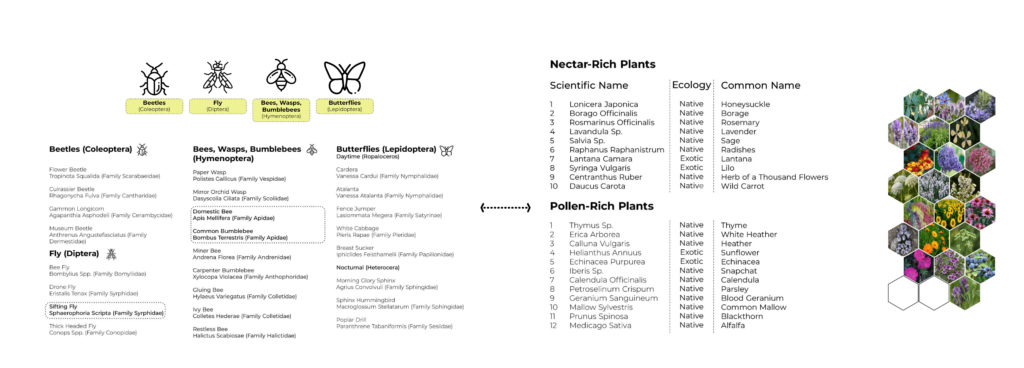
Madrid, Methodology & Analysis
On understanding pollination, the species involved, and narrowing down the highest contributors, the analysis for the city, Madrid is done. The green areas of the city was studied in order to identify the zones that lack these spaces which could potentially be the areas to further carry out the intervention to create connectivity between these zones.
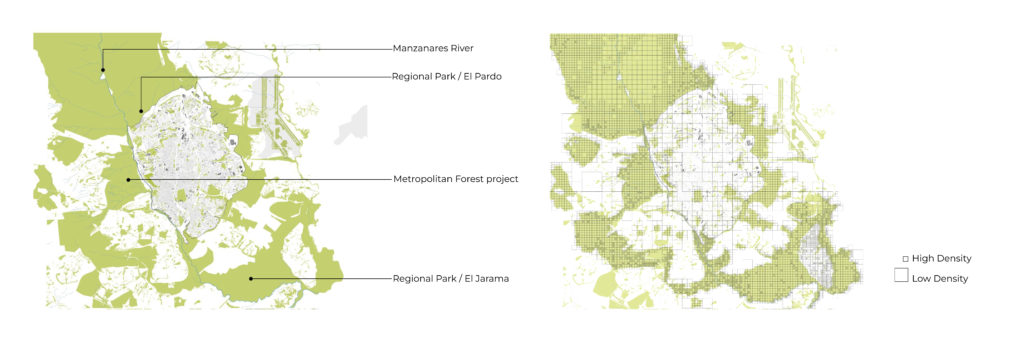
An analysis on the ecological performance of the area of the city of Madrid and its proximity context. On the one hand, considering the elements that contribute positively, or in other words offer a low resistance to the process of pollination. These areas include from bare soil to sparse and dense vegetation amongst meadows, grasslands, parks, and graveyards.

The main conditions which negatively impact the pollination withing the city, offering a high resistance: the illumination, the noise, the land fragmentation and, the urban morphology.
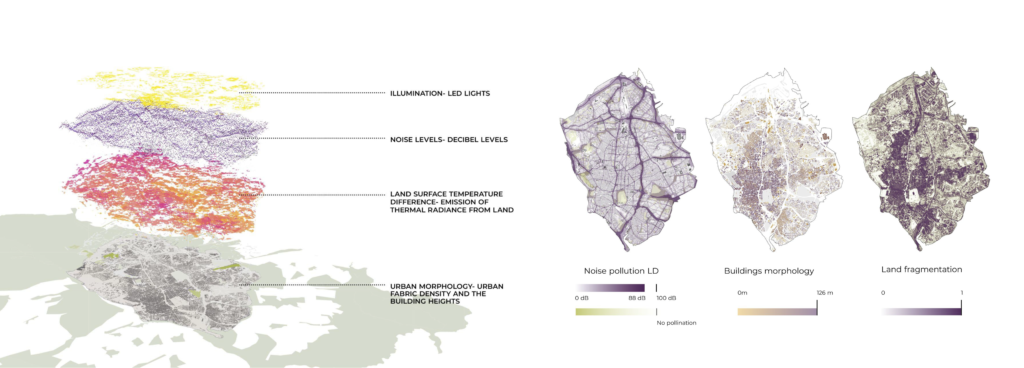
Throughout this process of both detecting focal points, where pollinators are presumed to have been thriving, and assigning resistances to the urban environment, a simulation was run to identify patterns of movement via Circuitscape software to identify clear ecological paths within the city. Moreover, we altered the resistance values of the existing conditions to generate clear evidence of potential areas of action. The result highlights three main areas of intervention to reactivate or enhance pollination: the historical city centre located in the southwest, the entire north-south spine, and the northern urban development.
Scanning the Ecological Corridor
The current project focuses on the Centro district, for having great challenges and opportunities due to its compact and dense urban fabric and the variety in the typology of stakeholders. The main challenge was then to establish a strategy to create a network of green spaces that connect Parque de El Retiro, and the natural reserve of Casa de Campo. The strategy is to take action on three crucial urban layers:
· Rooftops (which will generally be flat roofs)
· Plazas (with a civic character)
· Facades/Walls (of public, private and residential buildings)

To further understand the connectivity of the green areas in the historic center of Madrid, another simulation was run. The identification of a potential corridor to start the intervention was established.
On identifying the area of intervention, a study on urban potential elements which are, the rooftops, the plazas and the facades was carried out. To start with, the filtration for the typologies- the public services buildings, offices, commercial complexes, schools and museums were studied to identify the potential buildings. Simultaneously, the nearest plazas were identified which could be correlated to establish a corridor in different levels to create a multi-dimensional zone for navigation of these species. The distances between these buildings was also taken into consideration in order to satisfy the average flight ranges of the insect species.
As the intervention aims to be as much specific and as concrete as possible, a further scanning is undertaken across the above layers, based on parameters such as area, sun exposure, slope, vegetation, occupancy, and typology among others.
The Proposal
The projects interventions around the “Plaza de San Martin” include a redesign of the Plaza itself, with an introduction of the Totem and modular urban furniture. Urban gardening on commercial and public rooftops to provide herbs, fruits, vegetables and flowers for local restaurants, cafés and markets.
The possibilities for specific biodiversity relies on various dependencies, such as orientation, roof type or the vision of the involved stakeholders. At the same time the specific biodiversity grants an all year blooming nectar-rich and pollen-rich environment for pollinators within the city. To grant a high performance system, artificial Intelligence in form of Do-It-Yourself Arduino Sensor kits measures soil quality and water consumption among others. The redesign of the Plaza de San Martin includes various typologies of modular urban furniture, functioning as well as planter boxes, providing space for various biodiversity. Change of colour for the pavement, a pattern of purple circles reflecting the density of biodiversity, helps reducing the urban heat island effect (UHI) and acts as a symbol for guiding bees through the dense urban fabric.
The project proposes a “green facade” for the museum “Monasterio de las Descalzas Reales” for educational purpose in collaboration with the museum, local schools and organisations such as the “Sierra Norte” beekeeping association or the “Flor de Madrid”. Further on, a green facade for a retail & office building is proposed as it has south orientation which could reduce the energy consumption by up to 25%, even though specific plantation is required because of the higher radiation for south oriented facades. Beekeeping managed by the “Sierra Norte” association can take place on the extensive green roof of the retail & office building as the access and space here are limited.

Plaza: Modular furniture units and planter boxes containing native flowers are designed to organize the plazas’ public spaces and transform them into more natural environments, far from existing impermeable and neutral paved surfaces. A new colour palette is introduced to attract and help guiding pollinators across the city.
Rooftop: As part of the process, urban gardening for the local communities play an important role to learn about how to make your own green rooftop, the different typologies depending on the use and plant typologies that best contribute to it.
Façade: The vertical greening is done by having a framework for climbers or planter boxes which is provided with irrigation systems. These walls are populated with the wildflower species which attract insect pollinators.
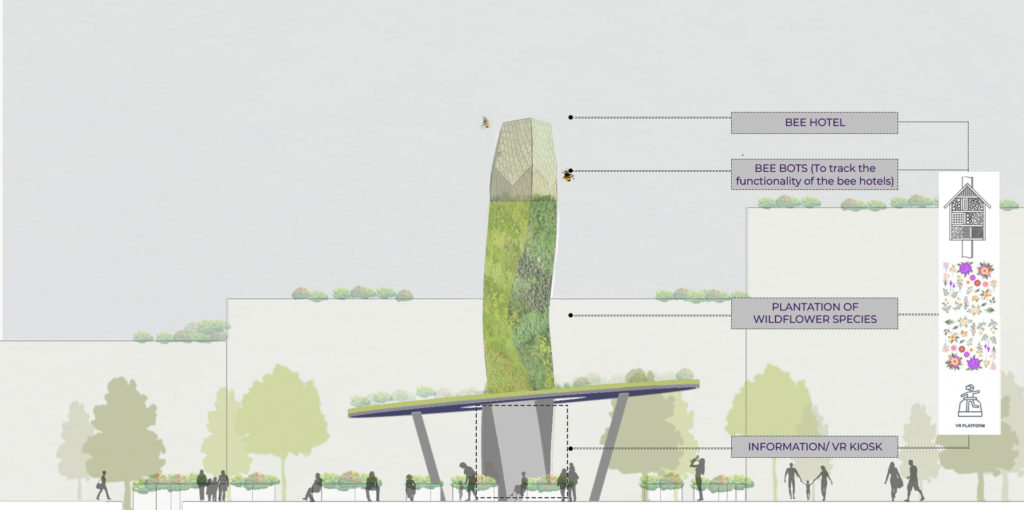
The Pollin [ART] orts : Urban Festival of Digital Arts of Madrid
MMMAD is Madrid’s Urban Digital Arts Festival, based on the exhibition, dissemination and thinking around digital creation. Focused on the intersection between digital culture and public space, the festival has a programme consisting of exhibitions, installations, calls, workshops, conferences and meetings throughout the city.
1 / bringing closer digital art to the general public
2 / innovating in formats and spaces for digital art, creating hybrid experiences between the physical and digital worlds that escape from conventional formats
3 / transforming public space into a space for digital art converting urban advertising media into cultural spaces
4 / supporting emerging talent, programming young artists and creators alongside established national and international artists.
This project seeks to be part of MMMad 2023 edition to raise awareness around the topic of pollination in our cities, and the importance of it for the stability of our ecosystem.
A depiction of the display of digital art on the facades which revolves around the theme of importance of taking immediate action on enhancing pollination within the city. This helps with creating awareness among various communities.
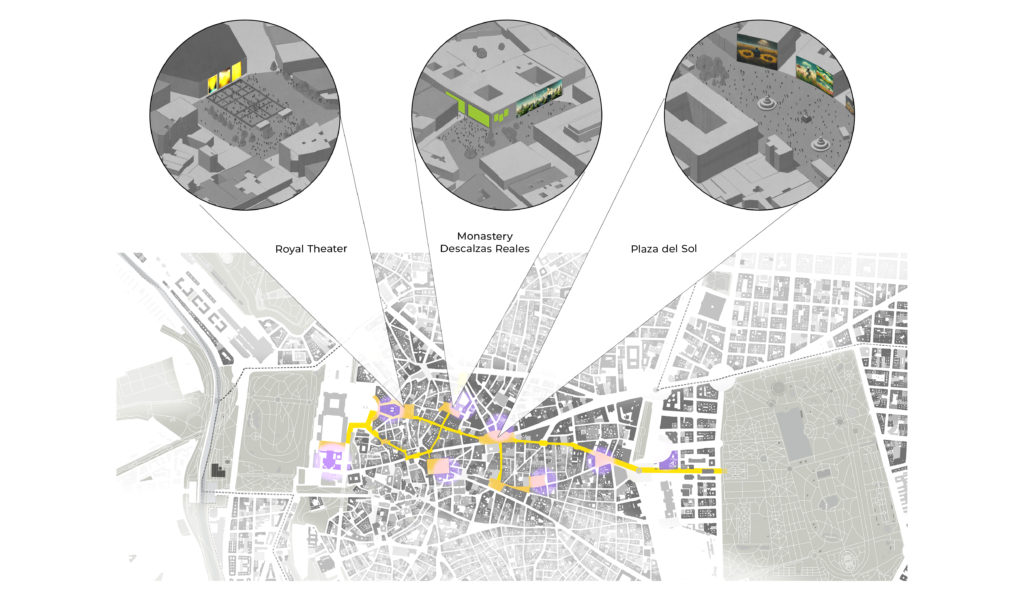
A Holistic Intervention for Madrid
From the process carried out to create a connecting corridor, a further analysis was done to identify all the potential rooftops, facades and plazas across the city of Madrid to establish a connectivity keeping in account the average flight ranges of the insect species. The below cartography depicts the identified buildings and plazas with a buffer of 150m and 75m which shows the possible connectivity zones within the city on a city scale.
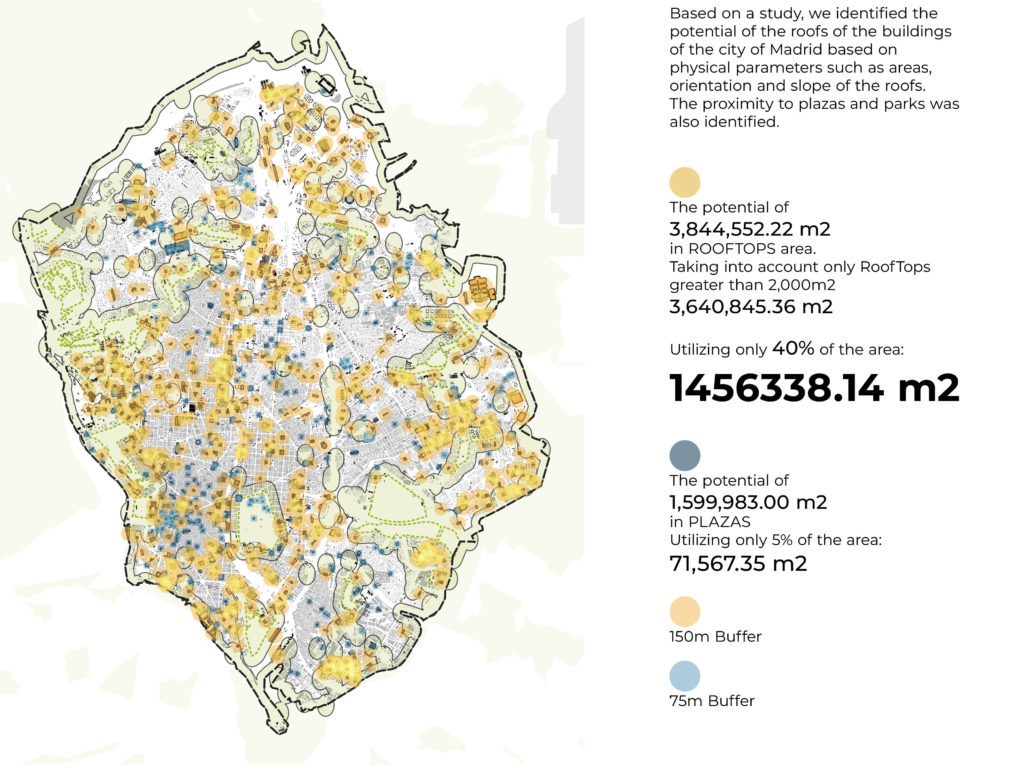
This intervention depicts the possibility of reviving the biodiversity within the city, the decline of the plant and the insect species, possible generation of revenue from the stakeholders considered. Overall, the project attempts to portray a potential approach in making the city more green, to bring in pollinators into the city, to counteract the increasing pressing issues of the change in climate, the increased Urban Heat Island effect, poor air quality, etc. The aim is to bring down the resistances considered which would in turn lead to spur up the city with increased biodiversity.

